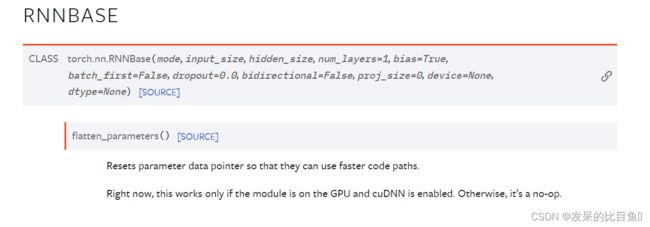小白学Pytorch系列--Torch.nn API Recurrent Layers(8)
小白学Pytorch系列–Torch.nn API Recurrent Layers(8)
![]()
| 方法 | 注释 |
|---|---|
| nn.RNNBase | |
| nn.RNN | 将具有tanh tanh或ReLU ReLU非线性的多层Elman RNN应用于输入序列。 |
| nn.LSTM | 将多层长短期记忆(LSTM) RNN应用于输入序列。 |
| nn.GRU | 将多层门控循环单元(GRU) RNN应用于输入序列。 |
| nn.RNNCell | 具有tanh或ReLU非线性的Elman RNN单元。 |
| nn.LSTMCell | 长短期记忆(LSTM)细胞。 |
| nn.GRUCell | 门控循环单元(GRU)细胞 |
nn.RNNBase
重置参数数据指针,以便它们可以使用更快的代码路径。
目前,只有当模块在GPU上并且启用了cuDNN时,这才有效。否则,这就是拒绝。

nn.RNNCell
h ′ = tanh ( W i h x + b i h + W h h h + b h h ) h' = \tanh(W_{ih} x + b_{ih} + W_{hh} h + b_{hh}) h′=tanh(Wihx+bih+Whhh+bhh)


rnn = nn.RNNCell(10, 20)
input = torch.randn(6, 3, 10)
hx = torch.randn(3, 20)
output = []
for i in range(6):
hx = rnn(input[i], hx)
output.append(hx)
nn.RNN
将具有tanh或ReLU非线性的多层Elman RNN应用于输入序列。对于输入序列中的每个元素,每个层计算以下函数:


import torch.nn as nn
import torch
model = nn.RNN(input_size=10, hidden_size=100, batch_first=True, num_layers=2, bidirectional =True)
input_tensor = torch.randn(2, 5, 10 )
output, hidden = model(input_tensor)
print(output.shape) # [bz, seq_len, hz]
print(hidden.shape) # [num_layer*D, bz, hz]
nn.LSTMCell
>>> rnn = nn.LSTMCell(10, 20) # (input_size, hidden_size)
>>> input = torch.randn(2, 3, 10) # (time_steps, batch, input_size)
>>> hx = torch.randn(3, 20) # (batch, hidden_size)
>>> cx = torch.randn(3, 20)
>>> output = []
>>> for i in range(input.size()[0]):
... hx, cx = rnn(input[i], (hx, cx))
... output.append(hx)
>>> output = torch.stack(output, dim=0)
nn.LSTM
将多层长短期记忆(LSTM) RNN应用于输入序列。
对于输入序列中的每个元素,每一层都计算以下函数





>>> rnn = nn.LSTM(10, 20, 2)
>>> input = torch.randn(5, 3, 10)
>>> h0 = torch.randn(2, 3, 20)
>>> c0 = torch.randn(2, 3, 20)
>>> output, (hn, cn) = rnn(input, (h0, c0)) # [seq_len, bz, bi*hz]
nn.GRUCell
>>> rnn = nn.GRUCell(10, 20)
>>> input = torch.randn(6, 3, 10)
>>> hx = torch.randn(3, 20)
>>> output = []
>>> for i in range(6):
... hx = rnn(input[i], hx)
... output.append(hx)
nn.GRU
>>> rnn = nn.GRU(10, 20, 2)
>>> input = torch.randn(5, 3, 10)
>>> h0 = torch.randn(2, 3, 20)
>>> output, hn = rnn(input, h0)








